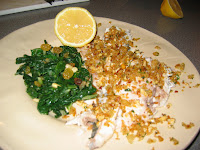First, starting with a local item. It looks like the Soup Nazi is coming to the ‘Burgh. Can’t wait to try the lobster bisque.
Next, and this is old news by now, but for anybody who missed it, particularly sushi fans, you might want to think twice about getting that spicy tuna roll the next time you’re looking to get some of those good fats. As the New York Times reported last week, mercury levels from sushi the newspaper purchased at 20 different places throughout
“No one should eat a meal of tuna with mercury levels like those found in the restaurant samples more than about once every three weeks," said Dr. Michael Gochfeld, professor of environmental and occupational medicine at the Robert Wood Johnson Medical School in Piscataway, N.J.
So, not only is bluefin tuna – often the tuna of choice at many sushi restaurants – way overfished and starting to become dangerously depleted, but it’s also warehousing the mercury from all of that wonderful industrial waste finding it’s way into to the ocean. What an unexpected two-fer!! Listen to this guy – for the time being, skip the tuna sashimi and try the mackerel.
Sticking with the good news (and New York Times) theme, Mark Bittman leaves behind his “Minimalist” persona for a day to become the food eco warrior. While I would never say this is scintillating narrative, it is a collection of some scary facts. Here are some of the highlights, but do be sure to check out the whole article, if for nothing else than the disturbing picture of a factory cattle farm.
Just this week, the president of Brazil announced emergency measures to halt the burning and cutting of the country’s rain forests for crop and grazing land. In the last five months alone, the government says, 1,250 square miles were lost.
The world’s total meat supply was 71 million tons in 1961. In 2007, it was estimated to be 284 million tons. Per capita consumption has more than doubled over that period.
And
an estimated 30 percent of the earth’s ice-free land is directly or indirectly involved in livestock production, according to the United Nation’s Food and Agriculture Organization, which also estimates that livestock production generates nearly a fifth of the world’s greenhouse gases — more than transportation.
And
Though some 800 million people on the planet now suffer from hunger or malnutrition, the majority of corn and soy grown in the world feeds cattle, pigs and chickens.
Next up, some interesting stuff coming out about folic acid — some of the stuff added to cereals and pasta and other foods to “fortify” them. Well, there are some concerns that maybe all of this fortification isn’t a risk-free proposition.
As many as 1,000 newborns a year in the United States - and many more elsewhere - have been spared so-called neural tube defects because their mothers got a crucial infusion of folic acid before they even knew they were pregnant.
But now some scientists are asking whether there have been unforeseen trade-offs for the population as a whole - including thousands of additional colon cancer cases each year, a somewhat smaller bump-up in prostate cancer, and an increase in cognitive impairment among the elderly.
This is all very preliminary stuff, but it’s something that hopefully will be further investigated.
Finally, once the weather breaks and the birds are chirping and the flowers are blooming and the Pirates begin their glorious march toward their 16th straight losing season, we’ll be transforming our garden into a Victory Garden.









